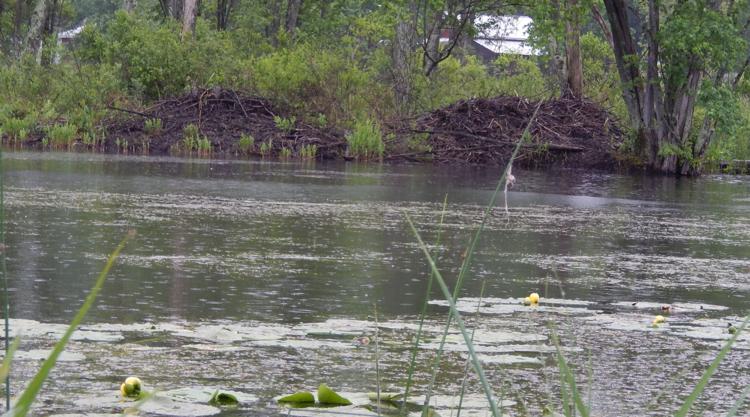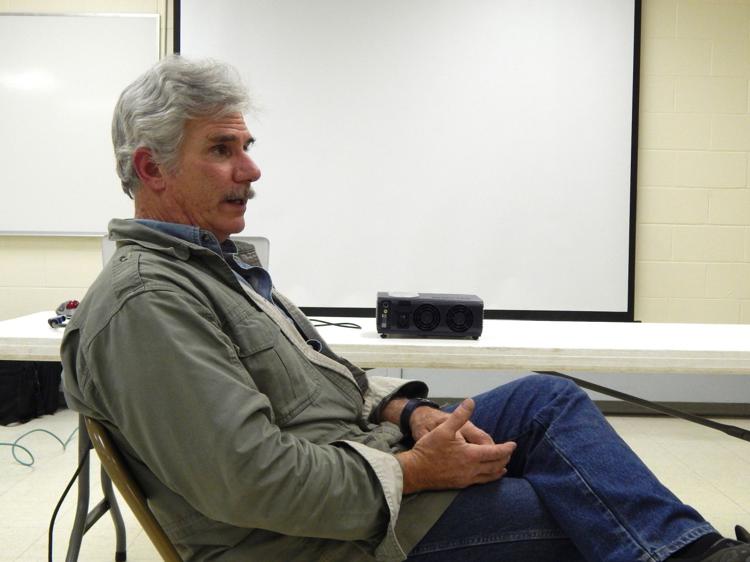Traveling to Placer county and preaching the beaver gospel used to be like going to the lions to recommend vegetarianism. But yesterday was more like preaching to the choir. It was a positive, beaver affirmed or beaver-curious group, and our good friends Janet, Jeanette and Damion Ciotti of FWS showed up. They each had wonderful comments and questions, and I made sure Damion connected with the tribal liaison who might just need to be reintroducing some beavers soon and get the federal government to foot the bill for the flow device. I was also excited that Jeanette was interested in an Auburn test site and especially interested when I told her that PGE (where she works) in Auburn had received on of the depredation permits in 2013. Wouldn’t it be good for beavers, and correspondingly good for PGE to be all environmental and generate some press for installing a flow device instead and saving wildlife?
I felt great when we left but I came home to news that our opening band for the festival had dropped out, so I scrambled at a great rate to recover territory I had secured in March. Then before I went to sleep I had the great news that soon-to-be-beaver author Ben Goldfarb will be coming to the festival after all. Which is a relief because I would have been so sad if he missed it. He’s also coming next week to get the story and lay of the land. It should all work out well, fingers crossed.
I see that our good friend Rusty Cohn has his photos proudly displayed in the Napa register today. It’s a great photo essay that you will enjoy on every level – meaning the level where it’s just cool to see beavers and the wildlife they encourage, AND the other more important level where our lovely Napatopia is inches away from screwing with the habitat but good and needs to be reminded that save beaver streams matter.
Photos: Life at Napa’s Beaver Lodge at Tulocay Creek
T he Tulocay Creek beaver pond is located next to the Hawthorne Suites Hotel, 314 Soscol Ave., Napa. At the creek, you’ll find river otters, mink, muskrats and herons as well as beavers. Here are some photos of the critters taken by local photographer Rusty Cohn.
he Tulocay Creek beaver pond is located next to the Hawthorne Suites Hotel, 314 Soscol Ave., Napa. At the creek, you’ll find river otters, mink, muskrats and herons as well as beavers. Here are some photos of the critters taken by local photographer Rusty Cohn.
I can’t figure out how to embed the entire album here, but you’re just going to have to go see it yourself. Trust me, you don’t want to miss it.
Now, in the middle of all this there’s a wonderful article about urban wildlife published in the SF Gate and all over this morning. The original was published on The Conversation and it is written by Christopher Swan who’s a Professor of Environmental Systems at the University of Maryland. I’m sure ever single reader of this website will have some flat-tailed suggestions for Chris.
Urban nature: What kinds of plants and wildlife flourish in cities?

Biodiversity refers to the variety of all living things on Earth, but people often have very specific ideas of what it means. If you run an online search for images of biodiversity, you are likely to find lots of photos of tropical rainforests and coral reefs.
Those ecosystems are invaluable, but biodiversity also exists in many other places. More than half of the people on Earth live in cities, and that number is growing, so it is especially important to understand how biodiversity patterns occur in our man-made environments.
As an ecologist specializing in urban systems, I spend a lot of time investigating biodiversity in parks, residential areas and abandoned zones in and around the city of Baltimore. My main interests are seeing how urban dwellers invest in biodiversity, which species persist in cities and what kinds of biodiversity can thrive in green spaces.
In spite of the substantial environmental changes that humans have caused in cities, research shows that they still contain many forms of life. And we can develop and maintain habitat to support them.
It is common to assume that few other species remain in disturbed urban environments. But in fact, there are many pockets of biodiversity in and around cities, such as frogs living in stormwater detention ponds and trees in restored streamside forests. Landscapes that people create in and around their homes support many ornamental herbaceous and woody plant species.
Our research group works to understand the relationship between people and urban biodiversity patterns. The most prominent feature of the urban environment is that it is fragmented into many small zones. Human activity creates more patches of smaller size and greater edge lengths between types of habitats than we would expect to see in undisturbed areas.
This benefits species that thrive at edges, like white-tailed deer and nuisance vines, but harms others that require larger interior habitats, such as certain birds. As human activities create a more fragmented environment, it becomes increasingly important to create linkages between natural areas, such as preserved forests, to maintain populations and their biodiversity.
Dr. Swanson! Have I got a story for you! You can bet I’ll be writing the good man just as soon as I finish finding a band to open the Urban wildlife festival that is observing its TENTH year. I love this article and love even more that folks are paying close attention to this topic, because it can only be good news for beavers and humans.
Now yesterday I got some designs from artist Deborah Hocking about our awesome bookmark she is designing very generously for the festival. Look how frickin’ cute this is going to be:
Deborah! That is sooo adorable and perfect for the occasion. I love where your design is going and can’t wait to see the finished project. I know this has been a crazy post of uneven tone. I can’t even see the line from the beginning of my day to the end, it was so full of ups and downs. On the whole I guess there are more ups.
But I still think it’s time to start calming my frazzled nerves by watching this over and over again:



 ASHERN — A certain buck-toothed, flat-tailed national symbol with a waddling gait is wreaking havoc in parts of Manitoba on a scale not seen in a lifetime. Armies of beaver are penetrating deeper and deeper inland in the Interlake and some other parts of Manitoba, flooding farm fields with their dams and destroying municipal infrastructure such as roads.
ASHERN — A certain buck-toothed, flat-tailed national symbol with a waddling gait is wreaking havoc in parts of Manitoba on a scale not seen in a lifetime. Armies of beaver are penetrating deeper and deeper inland in the Interlake and some other parts of Manitoba, flooding farm fields with their dams and destroying municipal infrastructure such as roads.





 As the Spencer Village Board of Trustees continues to ponder the beaver problem that has been plaguing Nichols Pond, they sought input from expert Scott MacDonald, who has had to deal with the industrious critters in his capacity as executive director of the Waterman Conservation Education Center in Appalachin.
As the Spencer Village Board of Trustees continues to ponder the beaver problem that has been plaguing Nichols Pond, they sought input from expert Scott MacDonald, who has had to deal with the industrious critters in his capacity as executive director of the Waterman Conservation Education Center in Appalachin. Goodrich said that he is not opposed to having the beavers killed, a resolution that none of the other trustees were very enthusiastic about supporting.
Goodrich said that he is not opposed to having the beavers killed, a resolution that none of the other trustees were very enthusiastic about supporting.




































